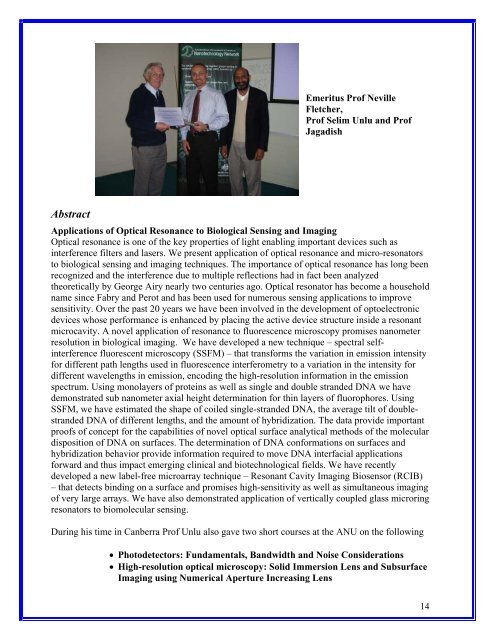Annual Report 2007 - The Australian Nanotechnology Network
Annual Report 2007 - The Australian Nanotechnology Network
Annual Report 2007 - The Australian Nanotechnology Network
You also want an ePaper? Increase the reach of your titles
YUMPU automatically turns print PDFs into web optimized ePapers that Google loves.
Abstract<br />
Emeritus Prof Neville<br />
Fletcher,<br />
Prof Selim Unlu and Prof<br />
Jagadish<br />
Applications of Optical Resonance to Biological Sensing and Imaging<br />
Optical resonance is one of the key properties of light enabling important devices such as<br />
interference filters and lasers. We present application of optical resonance and micro-resonators<br />
to biological sensing and imaging techniques. <strong>The</strong> importance of optical resonance has long been<br />
recognized and the interference due to multiple reflections had in fact been analyzed<br />
theoretically by George Airy nearly two centuries ago. Optical resonator has become a household<br />
name since Fabry and Perot and has been used for numerous sensing applications to improve<br />
sensitivity. Over the past 20 years we have been involved in the development of optoelectronic<br />
devices whose performance is enhanced by placing the active device structure inside a resonant<br />
microcavity. A novel application of resonance to fluorescence microscopy promises nanometer<br />
resolution in biological imaging. We have developed a new technique – spectral selfinterference<br />
fluorescent microscopy (SSFM) – that transforms the variation in emission intensity<br />
for different path lengths used in fluorescence interferometry to a variation in the intensity for<br />
different wavelengths in emission, encoding the high-resolution information in the emission<br />
spectrum. Using monolayers of proteins as well as single and double stranded DNA we have<br />
demonstrated sub nanometer axial height determination for thin layers of fluorophores. Using<br />
SSFM, we have estimated the shape of coiled single-stranded DNA, the average tilt of doublestranded<br />
DNA of different lengths, and the amount of hybridization. <strong>The</strong> data provide important<br />
proofs of concept for the capabilities of novel optical surface analytical methods of the molecular<br />
disposition of DNA on surfaces. <strong>The</strong> determination of DNA conformations on surfaces and<br />
hybridization behavior provide information required to move DNA interfacial applications<br />
forward and thus impact emerging clinical and biotechnological fields. We have recently<br />
developed a new label-free microarray technique – Resonant Cavity Imaging Biosensor (RCIB)<br />
– that detects binding on a surface and promises high-sensitivity as well as simultaneous imaging<br />
of very large arrays. We have also demonstrated application of vertically coupled glass microring<br />
resonators to biomolecular sensing.<br />
During his time in Canberra Prof Unlu also gave two short courses at the ANU on the following<br />
• Photodetectors: Fundamentals, Bandwidth and Noise Considerations<br />
• High-resolution optical microscopy: Solid Immersion Lens and Subsurface<br />
Imaging using Numerical Aperture Increasing Lens<br />
14



